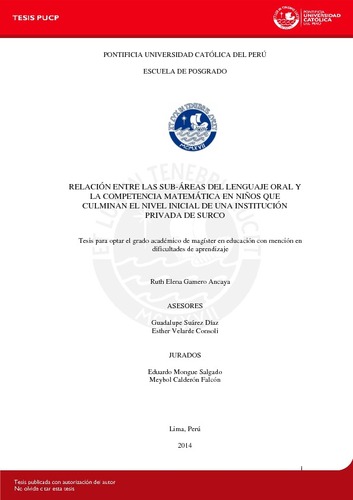Relación entre los subsistemas del lenguaje oral y la competencia matemática en niños que culminan el nivel inicial de una institución privada de Surco.
Abstract
Esta investigación estudia dos grandes aspectos dentro del desarrollo humano, el
lenguaje oral y la competencia matemática.
El lenguaje oral puede ser definido como la facultad específica humana de
comunicarse por medio de signos articulados y está compuesto por cinco sub-áreas:
fonética-fonológica, morfosintáctica, semántica y pragmática. Esta última no ha
sido considerada en el estudio por tener una connotación más sobre producción oral
que comprensión oral. Por otro lado, la competencia matemática, es considerada
como la capacidad para razonar, analizar, comunicar operaciones matemáticas y
emplear el razonamiento matemático en la vida diaria.
Esta investigación tiene como objetivo central determinar si existe correlación
significativa entre las sub-áreas del lenguaje oral y la competencia matemática en
niños que culminan el nivel inicial de un colegio privado de Surco. La metodología
utilizada corresponde a un enfoque cuantitativo de tipo no experimental de diseño
transversal. Para lograr el objetivo de la investigación se aplicaron dos pruebas, la
Evaluación de Lenguaje oral – ELO (Ramos, Cuadrado & Fernández, 2008) y la
Evaluación de Competencia Matemática – EVAMAT 0 (García et al., 2009) a un
muestra no probabilística de 58 estudiantes de 5 y 6 años.
Gracias a esta investigación se ha podido determinar que existe relación
significativa entre algunos de los aspectos del lenguaje oral, (fonológico y
semántico) y la competencia matemática. Asimismo, existe correlación entre el
lenguaje oral y la competencia matemática.
Palabras claves: Lenguaje oral, competencia matemática, aspecto fonológico,
aspecto sintáctico, aspecto semántico. This research studies two important aspects in the human development, the oral
language and the mathematical competence.
On one hand, the oral language, that is the human ability to communicate among us
through articulate sings. It has five subsystems: phonetic-phonological,
morphsyntactic, semantic and pragmatic. The pragmatic subsystem was not
consider in this research because it has connotation about oral production not about
oral comprehension. On the other hand, the mathematical competence, that is the
ability to think, analyze, communicate mathematical operations and use the
mathematical reasoning in daily life.
The main aim of this research is to determinate whether there is a meaningful
interrelationship between the oral language subsystem and the mathematical
competence in children that are finishing preschool in a private school in Surco.
This research follows a quantity approach of non-experimental transversal type. To
achieve the aim of this research two tests were taken Evaluación de Lenguaje oral
– ELO (Ramos, Cuadrado & Fernández, 2008) and Evaluación de Competencia
Matemática – EVAMAT 0 (García et al., 2009), to evaluate mathematical
competence, using a non-probabilistic sample of 58 students of 5 years-old and 6
years-old.
A meaningful relationship between some of the oral aspects (phonological and
semantic) and the mathematical competence was found. Also, a interrelationship
between the oral language and the mathematical competence.
Key words: Oral language, mathematical competence, phonological aspect,
morphsyntactic aspect, semantic aspect.
Temas
Niños--Lenguaje.
Matemáticas--Estudio y enseñanza (Preescolar).
Matemáticas--Estudio y enseñanza (Preescolar).
Para optar el título de
Maestro en Educación con mención en Dificultades de Aprendizaje
The following license files are associated with this item:






